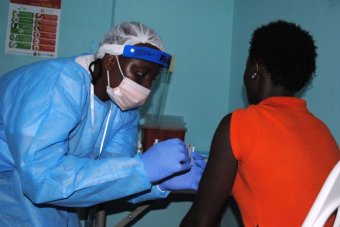An Australian researcher has helped to identify what has been described as the most effective model for human trials of Ebola vaccines.
Associate Professor Manoj Gambhir from Monash University’s Department of Epidemiology and Preventative Medicine is part of international team that has been examining the best way to undertake the trials in parts of West Africa to stop future outbreaks of the devastating virus.
The work comes as the World Health Organisation faces tough questions about its response to the recent crisis, which has killed more than 11,000 people.
Dr Gambhir has been part of the project for the past six months and said they were trying a “relatively novel approach”.
“[The approach is] to use a computer simulation to try to determine whether the design of the trial of the vaccine itself was correct, to be able to determine whether the vaccine that was being trialled out there in West Africa — both in Sierra Leone and Liberia — was going to be the correct design to be able to determine whether the vaccine had efficacy or not.”
The scientists used computers to map the spread of the virus and the software then determined the best candidates for the vaccine.
That is known as a “randomised control trial”, and Dr Gambhir said it was more effective than trying to conduct tests over huge parts of each country.
“One particular characteristic of the Ebola outbreak is it certainly hasn’t been uniform across the countries, in Guinea, Sierra Leone and Liberia,” he said.
“It’s been really patchy across those countries, and it’s had a very changing characteristic over time.
“So given that changing geographical characteristic, but also the temporal time dependent characteristic of how the disease is changing, we can basically impose the trial design and give vaccines to individuals who are located within particular counties.”
An alternative way to conduct human trials is known as the “stepped wedge design”, where everyone in a broader affected area gets the vaccine.
But Dr Gambhir said choosing random recipients could generate the same results faster.
“You hopefully will end up with a group who receive it, who are basically very similar in their characteristics to those who do not receive it,” he said.
“So in terms of their age, in terms of their gender, in terms of their location and generally their risk of acquiring the disease.”
Liberia was declared free of Ebola this month after 42 days without a case. But there are still new cases in Sierra Leone.
Dr Gambhir said Guinea presented the biggest challenge.
“It’s been more difficult in Guinea,” he said.
“More of its land area is forest, and it’s difficult to access.
“It’s been the country that’s been most difficult to patrol as well for Ebola.”
‘The buck stops with me’, WHO chief says amid criticism
The virus first hit Guinea in December 2013, spreading quickly to Liberia and Sierra Leone.
But it was not until August 2014 — nine months later — that the World Health Organisation (WHO) declared an international public health emergency.
Director-general Margaret Chan told the WHO’s annual general meeting in Geneva that the organisation failed to respond adequately.
“I do not ever again want to see this organisation faced with a situation [where] it is not prepared, staffed, funded, or administratively set up to change and manage all these changes,” she said.
Dr Chan has announced a $100 million contingency fund to ensure the WHO has the money to respond quickly and efficiently in the future.
She is also establishing a global health emergency workforce and a unified program for health emergencies, linking the WHO’s national, country and regional headquarters.
But after being at the helm for more than eight years, Dr Chan has come under fire for being slow to respond to the epidemic and was asked whether she had been pressured to resign.
“The buck stops with me,” she told the annual assembly.
“As a responsible leader, you need to learn the lessons and make the right changes.”
According to the latest WHO summary published this week, 27,000 people contracted Ebola across the three West African countries

